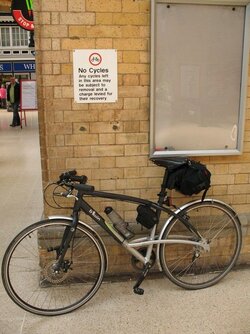velovoice
Veteran
- Location
- Between the City and the Sea
I've got a late 1970s Puch mixte-frame road bike, which - I think - from the general history of Continental mixtes from the 1960s-1970s - may have originally been designed as a distance/touring bike. I bought it off eBay last May, mainly for the appeal of the frame, but then found that all the mechanicals were original and in amazingly good condition. (At that point in time, my only bike was a Brompton. I was venturing for the first time into "full size bike" territory and just wanted something to get me round town and to/from work a little quicker - as I no longer needed to hop on/off trains.)
So I set it up as a town bike: http://www.flickr.com/photos/10938860@N03/sets/72157624128246558/.
Within a week, I realised this upright position was just all wrong for this bike and how it handles - I feel very strongly that the bike wants me to be leaning forward a lot more (a totally different riding style I'm only just beginning NOW to get into!). But, finances being what they are - I carried on riding it this way - mainly for commuting - even as I became interested in riding longer-distances... believe it or not, this 5-speed mixte, set up like this, has done the Dunwich Dynamo and the last two FNRttC!
In my head though, I was plotting a conversion to something more "road" orientated.... single speed with bullhorn bars? Hmmm...
WHILE ALSO shopping round for a proper touring/audax bike. Then a few weeks ago, I suddenly thought: "Hey, can the Puch do that??"
So my question is: Is this bike possibly - just possibly - a good candidate to be built up for doing audax/randonnée-type rides? It's light-ish and quick and responsive. And it's steel. It would need ALL new components though - we'd be talking a bare-frame-upwards rebuild. Which is why I need to be as sure as I can be beforehand that all this would pay off.
It would need ALL new components though - we'd be talking a bare-frame-upwards rebuild. Which is why I need to be as sure as I can be beforehand that all this would pay off.
The question really is, how do I go about measuring all the various angles of the bike to find out what its specific geometry is, to compare against those of bikes that are recognised as suitable for comfortable long-distance riding?
Do I need to take it in person to a frame designer/builder/fitter?
Cheers
So I set it up as a town bike: http://www.flickr.com/photos/10938860@N03/sets/72157624128246558/.
Within a week, I realised this upright position was just all wrong for this bike and how it handles - I feel very strongly that the bike wants me to be leaning forward a lot more (a totally different riding style I'm only just beginning NOW to get into!). But, finances being what they are - I carried on riding it this way - mainly for commuting - even as I became interested in riding longer-distances... believe it or not, this 5-speed mixte, set up like this, has done the Dunwich Dynamo and the last two FNRttC!

In my head though, I was plotting a conversion to something more "road" orientated.... single speed with bullhorn bars? Hmmm...
WHILE ALSO shopping round for a proper touring/audax bike. Then a few weeks ago, I suddenly thought: "Hey, can the Puch do that??"
So my question is: Is this bike possibly - just possibly - a good candidate to be built up for doing audax/randonnée-type rides? It's light-ish and quick and responsive. And it's steel.
 It would need ALL new components though - we'd be talking a bare-frame-upwards rebuild. Which is why I need to be as sure as I can be beforehand that all this would pay off.
It would need ALL new components though - we'd be talking a bare-frame-upwards rebuild. Which is why I need to be as sure as I can be beforehand that all this would pay off. The question really is, how do I go about measuring all the various angles of the bike to find out what its specific geometry is, to compare against those of bikes that are recognised as suitable for comfortable long-distance riding?
Do I need to take it in person to a frame designer/builder/fitter?
Cheers


 I'll tell ya though... right now, I can't picture doing the LEL on this!!
I'll tell ya though... right now, I can't picture doing the LEL on this!! 


